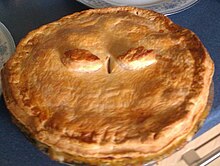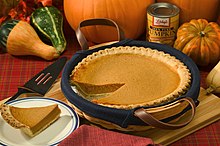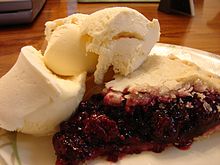Pie: Difference between revisions
m Spelling |
Pokenerd34 (talk | contribs) No edit summary |
||
| Line 25: | Line 25: | ||
Pies can be a variety of sizes, ranging from bite-size to ones designed for multiple servings. |
Pies can be a variety of sizes, ranging from bite-size to ones designed for multiple servings. |
||
Is it just me, or is this article making me hungry. |
|||
==History== |
==History== |
||
Revision as of 01:45, 6 May 2014
 A slice of an apple pie | |
| Main ingredients | Pie shell |
|---|---|
| Variations | Sweet pies, savoury pies |
A pie is a baked dish which is usually made of a pastry dough casing that covers or completely contains a filling of various sweet or savoury ingredients.
Pies are defined by their crusts. A filled pie (also single-crust or bottom-crust), has pastry lining the baking dish, and the filling is placed on top of the pastry but left open. A top-crust pie, which may also be called a cobbler, has the filling in the bottom of the dish and is covered with a pastry or other covering before baking. A two-crust pie has the filling completely enclosed in the pastry shell. Flaky pastry is a typical kind of pastry used for pie crusts, but many things can be used, including baking powder biscuits, mashed potatoes, and crumbs.
Pies can be a variety of sizes, ranging from bite-size to ones designed for multiple servings. Is it just me, or is this article making me hungry.
History



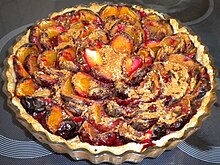
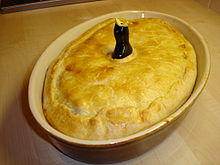
The need for nutritious, easy-to-store, easy-to-carry, and long-lasting foods on long journeys, in particular at sea, was initially solved by taking live food along with a butcher or cook. However, this took up additional space on what were either horse-powered treks or small ships, reducing the time of travel before additional food was required. This resulted in early armies adopting the style of hunter-foraging.
The introduction of the baking of processed cereals including the creation of flour, provided a more reliable source of food. Egyptian sailors carried a flat brittle bread loaf of millet bread called dhourra cake, while the Romans had a biscuit called buccellum.[1]
The first pies appeared around 9500 BC, in the Egyptian Neolithic period or New Stone Age. During this period the use of stone tools shaped by polishing or grinding, the domestication of plants and animals, the establishment of permanent villages, and the practice of crafts such as pottery and weaving became common. Early pies were in the form of flat, round or freeform crusty cakes called galettes consisting of a crust of ground oats, wheat, rye, or barley containing honey as a treat inside. These galettes developed into a form of early sweet pastry or desserts, evidence of which can be found on the tomb walls of the Pharaoh Ramesses II, who ruled from 1304 to 1237 BC, located in the Valley of the Kings.[2] Sometime before 2000 BC, a recipe for chicken pie was written on a tablet in Sumer.[3]
Ancient Greeks are believed to have originated pie pastry. In the plays of Aristophanes (5th century BC) there are mentions of sweetmeats including small pastries filled with fruit. Nothing is known of the actual pastry used, but the Greeks certainly recognized the trade of pastry-cook as distinct from that of baker. (When fat is added to a flour-water paste it becomes a pastry.) The Romans made a plain pastry of flour, oil, and water to cover meats and fowls which were baked, thus keeping in the juices. (The covering was not meant to be eaten; it filled the role of what was later called puff paste') A richer pastry, intended to be eaten, was used to make small pasties containing eggs or little birds which were among the minor items served at banquets. [4]
The 1st century Roman cookbook Apicius makes various mentions of recipes which involve a pie case.[5] By 160 BC, Roman statesman Marcus Porcius Cato (234-149 BC) who wrote De Agri Cultura, notes the recipe for the most popular pie/cake called Placenta. Also called libum by the Romans, it was more like a modern day cheesecake on a pastry base, often used as an offering to the gods. With the development of the Roman Empire and its efficient road transport, pie cooking spread throughout Europe.[2]
Pies remained as a staple of traveling and working peoples in the colder northern European countries, with regional variations based on both the locally grown and available meats, as well as the locally farmed cereal crop. The Cornish pasty is an excellent adaptation of the pie to a working man's daily food needs.[2]
Medieval cooks had restricted access to ovens due to their costs of construction and need for abundant supplies of fuel. Pies could be easily cooked over an open fire, while partnering with a baker allowed them to cook the filling inside their own locally defined casing. The earliest pie-like recipes refer to coffyns (the word actually used for a basket or box), with straight sealed sides and a top; open top pies were referred to as traps. This may also be the reason why early recipes focus on the filling over the surrounding case, with the partnership development leading to the use of reusable earthenware pie cases which reduced the use of expensive flour.[6]
The first reference to "pyes" as food items appeared in England (in a Latin context) as early as the 12th century, but no unequivocal reference to the item with which the article is concerned is attested until the 14th century (Oxford English Dictionary sb pie).[2]
Song birds at the time were a fine delicacy, and protected by Royal Law. At the coronation of eight-year old English King Henry VI (1422–1461) in 1429, "Partryche and Pecock enhackyll" pie was served, consisting of cooked peacock mounted in its skin on a peacock filled pie. Cooked birds were frequently placed by European royal cooks on top of a large pie to identify its contents, leading to its later adaptation in pre-Victorian times as a porcelain ornament to release of steam and identify a good pie.[2]
The Pilgrim fathers and early settlers brought their pie recipes with them to America, adapting to the ingredients and techniques available to them in the New World. Their first pies were based on berries and fruits pointed out to them by the Native North Americans.[2] Pies allowed colonial cooks to stretch ingredients and also used round shallow pans to literally "cut corners," and create a regional variation of shallow pie.[7]
Regional variations

Meat pies with fillings such as steak, cheese, steak and kidney, minced beef, or chicken and mushroom are popular in the United Kingdom,[8] Australia, South Africa and New Zealand as take-away snacks. They are also served with chips as an alternative to fish and chips at British chip shops.
Pot pies with a flaky crust and bottom are also a popular American dish, typically with a filling of meat (particularly beef, chicken, or turkey), gravy, and mixed vegetables (potatoes, carrots, and peas). Frozen pot pies are often sold in individual serving size.
Fruit pies may be served with a scoop of ice cream, a style known in North America as pie à la mode. Many sweet pies are served this way. Apple pie is a traditional choice, though any pie with sweet fillings may be served à la mode. This combination, and possibly the name as well, is thought to have been popularized in the mid-1890s in the United States.[9]
Pie throwing
Cream filled or topped pies are favorite props for humor. Throwing a pie in a person's face has been a staple of film comedy since Ben Turpin received one in Mr. Flip in 1909.[10] More recently, pieing has also become a political act.
Types of pies
Savory pies
- Savory pies
-
A chicken pie
Sweet pies
Some of these pies are pies in name only, such as the Boston cream pie, which is a cake. Many fruit and berry pies are very similar, varying only the fruit used in filling. Fillings for sweet or fruity are often mixed, such as strawberry rhubarb pie.
- Sweet pies
-
Pumpkin pie
-
Blackberry pie and ice cream
-
Raisin pie with a lattice-style crust
See also
References
- ^ "Ships Biscuits - Royal Navy hardtack". Royal Navy Museum. Retrieved 14 January 2010.
- ^ a b c d e f "History of Pie". whatscookingamerica.net. Retrieved 2010-07-05.
- ^ Somervill, Empires of Ancient Mesopotamia, p.69
- ^ "Food Pies". FoodTimeline.org. Retrieved 2010-07-05.
- ^ Joseph Dommers Vehling, ed. (1977). Apicius: Cookery and Dining in Imperial Rome. Dover:New York.
{{cite book}}:|access-date=requires|url=(help) - ^ Odile Redon; et al. (1998). The Medieval Kitchen: Recipes from France and Italy. University of Chicago Press:Chicago. ISBN 0-226-70684-2.
{{cite book}}:|access-date=requires|url=(help); Explicit use of et al. in:|author=(help) - ^ Andrew Smith (ed.). Oxford Encyclopedia of Food and Drink in America. Oxford University Press:New York.
{{cite book}}:|access-date=requires|url=(help) - ^ "Pie". Encyclopædia Britannica. Chicago. Retrieved 2008-09-12.
- ^ ""Remember the à la mode!" (pie à la mode)". Retrieved 2007-10-29.
- ^ "A Very Brief History of Slapstick". Splat TV. 2003. Retrieved 2009-01-29.
External links
- A Tale of Two Tarts by Monica Gaudio (contains info that can be added into article with references)
- Food Timeline, History Notes: Pie & Pastry
- A Wide Variety of Pie Recipes at recipeforpie.com

